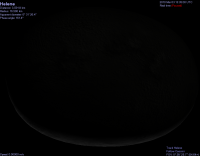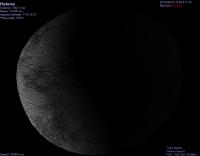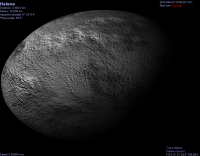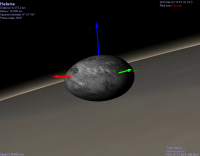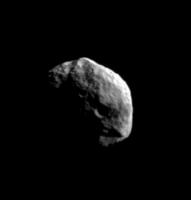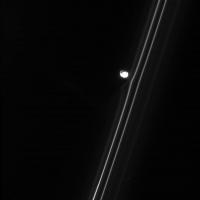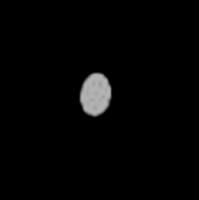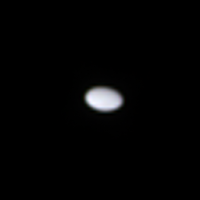Printable Version of Topic
Click here to view this topic in its original format
Unmanned Spaceflight.com _ Cassini's ongoing mission and raw images _ 'rock' satellite flybys
Posted by: jasedm May 16 2008, 06:37 PM
Cassini's orbits are now averaging 8-9 days apiece as the end of the prime mission approaches, and according to information posted on this forum, Cassini approaches within 75,000km of various 'rock' satellites EIGHTEEN times in the next ten weeks.
These flybys include the closest remaining encounters with Daphnis, Prometheus, Pandora, Epimetheus, Janus, and Pallene (all of these sub-30,000km).
Many close moon-encounters fall during Saturn eclipse, and there are many competing experiments around periapse, but hopefully there will be some planned ISS observations of these small moons at or around closest-approach...
![]()
![]()
Posted by: volcanopele May 16 2008, 06:52 PM
Just a quick scan: Janus (Jun 30; 59000 km; high phase angle), Pallene (August 19; 43000 km)
Posted by: DrShank May 16 2008, 07:11 PM
there is a sub-5000 km flyby of helene during extended mission, but i ve not yet found when!
cheers
paul
Posted by: volcanopele May 16 2008, 07:57 PM
It is on March 3, 2010 at 13:40:41UTC. Distance to Helene's surface is 1803.1 km.
Posted by: jasedm May 18 2008, 02:18 PM
Some long range images (around 350,000km ) of Janus have just been posted http://saturn.jpl.nasa.gov/multimedia/images/raw/casJPGFullS40/N00110904.jpg
Posted by: jasedm Jul 15 2008, 03:43 PM
Some more far-out janus shots have just been posted (seems like Janus is getting quite some attention at the moment)
This one from 255,000km, enlarged x2.5 and enhanced
Posted by: jasedm Jul 23 2008, 12:14 PM
A couple of new images of Prometheus/F-ring have been posted, this one taken from a distance of around 450,000km.
I can't think of a single image which demonstrates gravity better than this - Newton (the old curmudgeon) would have loved it.
Posted by: centsworth_II Jul 23 2008, 02:18 PM
Are you sure that's not the result of Prometheus' wake in the aether?
Posted by: Juramike Jul 23 2008, 02:22 PM
Forgive my really naive question: How do we know it's not due to electrostatics?
Posted by: jasedm Jul 23 2008, 03:37 PM
Perhaps both processes are visible here. I've read that the outer elements of the F-ring appear to be smoke-sized particles, in which case I wouldn't be surprised if the passing 'wake' of the moon stirred up some of the 'smoke' creating visible ripples, but the 'core' of the ring (the two brighter threads in the image) are made up of much larger constituents, and the obvious kink is surely gravitationally-produced...
Just for context, this image was taken from below the ring plane, with Prometheus further from Cassini (by 800km or so) than the core of the ring.
Posted by: 3488 Jul 23 2008, 07:40 PM
Hi everyone,
Think you may like this one. I'm surprised by the very high calibre of the membership here, this has been missed.
Janus in eclipse in Saturn's shadow, lit by the other moons from 33,000 KM. I have cropped, slightly enlarged it & brightened / contrast enhanced the image, as the original was very dark.
I'm afraid that I could do nothing about the cosmic ray / noise speckling.
Andrew Brown.
Posted by: jasedm Jul 23 2008, 08:35 PM
Hi Andrew, this is a view of Janus I've been looking forward to. I agree about the calibre of contributors here. Some of the very best image-smiths showcase their work on this site for all to enjoy.
This image though is Janus in sunlight just prior to eclipse - any image obtained by light due to Saturnshine would have been significantly degraded in terms of quality, and I don't think that there is enough light bouncing off adjacent moons to register in Cassini's optics during eclipse. (see versions of Helene posted in this section)
My own attempts to clean up this image owe more to artistic interpretation than anything else, and fall well short of standards here, so i've avoided posting them - I need some practice....
![]()
Posted by: volcanopele Jul 23 2008, 08:47 PM
It wasn't missed, just covered in a different thread: http://www.unmannedspaceflight.com/index.php?s=&showtopic=5130&view=findpost&p=119744
the increased noise is due to an increase in radiation levels in the region between Mimas and Janus/Epimetheus, not due to low light conditions.
Posted by: 3488 Jul 23 2008, 09:22 PM
Thanks VP for setting me straight. I was aware of the Janus eclipse, & thought as the original image was so dark, that was taken during said eclipse, not just before.
I see your enhancement, considerably better than mine. I assume the G Ring is responsible for the trapped radiation? I'm not as familiar with the Saturn system as I am of the Jupiter system.
Once again, thanks VP & its great talking to you again.
Hi jasedm, I'm aware of the Enceladus eclipse imagery a while back, faintly lit by Rhea, Dione & Tethys, with Cassini taking a longer exposure, but being further away with a much larger target, it seems to work. Janus is small & close in to Saturn, so yes that would probably not work thinking about it more logically.
Andrew Brown.
Posted by: ugordan Jul 23 2008, 09:26 PM
The image is dark because all the heavy radiation hits confused the automatic contrast stretch algorithm applied on the raws. It saw those high brightness pixels and thought it didn't need to brighten the image any more. In other words, this is closer to the actual 'raw' image downloaded from the spacecraft.
Posted by: jasedm Aug 14 2008, 09:35 AM
Can't compare to Enceladus' close-up of course, but Cassini has a moderately close approach (non-targeted) to the moon Pallene on the 19th August, and I understand there are some planned images in the sequences.
The approach distance is just under 40,000km, although images probably won't be taken bang-on C/A.
The moon is only ~4km across, but with luck, a few shots in the order of about 15 pixels in the NAC should be possible.
The best raw images I could find to date of Pallene were taken on June 8th 2005 and the distance to target is not given. From the apparent diameter of the moon in the images though, I'm guessing range was between 50,000km and 100,000km.
Below is one of those images cropped, enhanced, and magnified x4
The speckling evident is likely artefacts of the processing rather than actual surface features, but it does show pronounced non-sphericity.
Hopefully if the sequences on Rev 81 do include Pallene, we may see a crater or two at the high phase angles
Posted by: Ken90000 Aug 22 2008, 02:54 PM
Did we miss Pallene? The images appear blank. I had hoped that we would see some detail on its tiny ten-pixel surface.
Posted by: tallbear Aug 22 2008, 04:32 PM
Yes... Pallene was missed...No Live Update was performed
but it would not have mattered .... Pallene was in Eclipse .
T
Posted by: Ken90000 Aug 23 2008, 09:45 PM
Thanks, T
Perhaps there will be another opportunity later in the mission.
Posted by: jasedm Aug 24 2008, 02:29 PM
The relevant looking-ahead article on Ciclops suggested imaging attempts whilst Pallene was in direct sunlight, so was this a pointing error, or was that part of the sequence not uploaded to the spacecraft?
Cassini flies closer (around 30,000km) on 17th October this year, but I think there is a downlink during close-approach so images are unlikely to be planned.
This means no closer images than the 2005 ones in the XM. ![]()
Posted by: Floyd Feb 3 2009, 11:26 PM
Lots of great images of DAPHNIS--potential movie. In this http://saturn.jpl.nasa.gov/multimedia/images/raw/casJPGFullS47/N00128824.jpgyou can see Daphnis' shadow on the rings. Additional representative images http://saturn.jpl.nasa.gov/multimedia/images/raw/casJPGFullS47/N00128810.jpg, http://saturn.jpl.nasa.gov/multimedia/images/raw/casJPGFullS47/N00128822.jpg, http://saturn.jpl.nasa.gov/multimedia/images/raw/casJPGFullS47/N00128798.jpg. The gores seem to be drawn out of the plane and catch the sun.
Posted by: jasedm Feb 5 2009, 04:49 PM
It seems Daphnis kicks a lot of material up out of the ringplane and into sunlight as it orbits. It certainly causes more obvious ring material disturbances than does Pan within the Encke gap.
Posted by: ugordan Feb 5 2009, 05:20 PM
For what it's worth, here's that dataset in calibrated natural color, magnified 4x:
No other enhancements were done. Target distance was reported to be 76 000 km, phase angle 21 degrees. Effectively featureless surface, down to the NAC resolving power. It does appear to have a noticeable bluish tint to it, something http://flickr.com/photos/ugordan/384876136/, Pandora and inner ring moons don't share, but http://flickr.com/photos/ugordan/258907722/ does.
Posted by: Tom Tamlyn Feb 5 2009, 09:23 PM
Will there be any opportunities for better images of Pallene in the current mission?
TTT
Edit: The three Pallene encounters http://saturn.jpl.nasa.gov/mission/saturntourdates/saturntourdates2009/ are all further away the June 8, 2005 image (94,000 km or further).
Posted by: pat Feb 11 2009, 12:26 PM
TTT
Edit: The three Pallene encounters http://saturn.jpl.nasa.gov/mission/saturntourdates/saturntourdates2009/ are all further away the June 8, 2005 image (94,000 km or further).
there are no flyby observation of Pallene during 2009. The only Pallene flyby request in 2010 that is still a possibility is the one in rev 128 on DOY 79, that segment of the extended mission hasn't been integrated yet (the one in rev 130 on DOY 117 seems to be Dead Right There due to an RSS gravity pass during the Enceladus flyby)
Powered by Invision Power Board (http://www.invisionboard.com)
© Invision Power Services (http://www.invisionpower.com)

